

Citing Sources: Citing Orally in Speeches
- Citing Sources Overview
- Citing in the Sciences & Engineering
- APA Citation Examples
- Chicago Citation Examples
- Biologists: Council of Science Editors (CSE) Examples
- MLA Citation Examples
- Bluebook - Legal Citation
Citing Orally in Speeches
- Citation Managers
- Oral Source Citations - James Madison University Communication Center
- Using Citations and Avoiding Plagiarism in Oral Presentations - Hamilton College, Dept. of Rhetoric and Communication
- Referencing: Citing in Orals - James Cook University
General Tips:
Tell the audience your source before you use the information (the opposite of in-text citations).
Do not say, “quote, unquote” when you offer a direct quotation. Use brief pauses instead.
Provide enough information about each source so that your audience could, with a little effort, find them. This should include the author(s) name, a brief explanation of their credentials, the title of the work, and publication date.
“In the 1979 edition of The Elements of Style, renowned grammarians and composition stylists Strunk and White encourage writers to ‘make every word tell.’”
If your source is unknown to your audience, provide enough information about your source for the audience to perceive them as credible. Typically we provide this credentialing of the source by stating the source’s qualifications to discuss the topic.
“Dr. Derek Bok, the President Emeritus of Harvard University and the author of The Politics of Happiness argues that the American government should design policies to enhance the happiness of its citizens.”
Provide a caption citation for all direct quotations and /or relevant images on your PowerPoint slides.
Direct Quotations:
These should be acknowledged in your speech or presentation either as “And I quote…” or “As [the source] put it…”
Include title and author: “According to April Jones, author of Readings on Gender…”
Periodical/Magazine:
Include title and date: “Time, March 28, 2005, explains…” or “The New York Times, June 5, 2006, explained it this way…”
Include journal title, date, and author: “Morgan Smith writes in the Fall 2005 issue of Science…”
For organizational or long-standing website, include title: “The center for Disease Control web site includes information…” For news or magazine websites, include title and date: “CNN.com, on March 28, 2005, states…” (Note: CNN is an exception to the “don’t use the address” rule because the site is known by that name.)
Interviews, lecture notes, or personal communication:
Include name and credentials of source: “Alice Smith, professor of Economics at USM, had this to say about the growth plan…” or “According to junior Speech Communication major, Susan Wallace…”
- << Previous: Bluebook - Legal Citation
- Next: Citation Managers >>
- Last Updated: Apr 11, 2024 8:38 AM
- URL: https://libguides.wpi.edu/citingsources
How can we help?
- [email protected]
- Consultation
- 508-831-5410

Want to create or adapt books like this? Learn more about how Pressbooks supports open publishing practices.
7.3 Citing Sources
Learning objectives.
- Understand what style is.
- Know which academic disciplines you are more likely to use, American Psychological Association (APA) versus Modern Language Association (MLA) style.
- Cite sources using the sixth edition of the American Psychological Association’s Style Manual.
- Cite sources using the seventh edition of the Modern Language Association’s Style Manual.
- Explain the steps for citing sources within a speech.
- Differentiate between direct quotations and paraphrases of information within a speech.
- Understand how to use sources ethically in a speech.
- Explain twelve strategies for avoiding plagiarism.
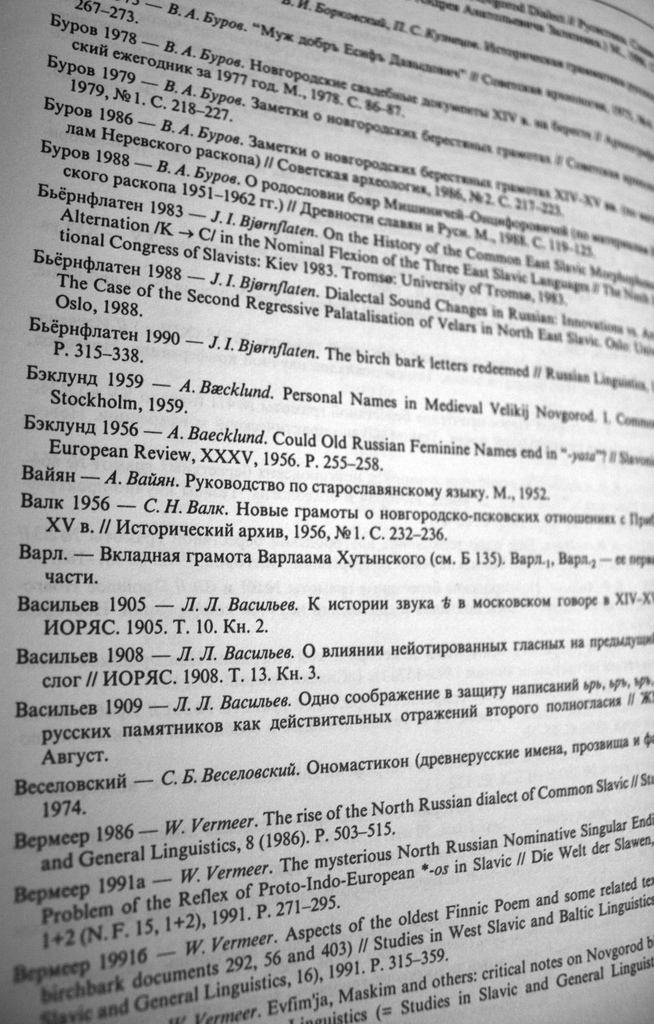
Quinn Dombrowski – Bilbiography – CC BY-SA 2.0.
By this point you’re probably exhausted after looking at countless sources, but there’s still a lot of work that needs to be done. Most public speaking teachers will require you to turn in either a bibliography or a reference page with your speeches. In this section, we’re going to explore how to properly cite your sources for a Modern Language Association (MLA) list of works cited or an American Psychological Association (APA) reference list. We’re also going to discuss plagiarism and how to avoid it.
Why Citing Is Important
Citing is important because it enables readers to see where you found information cited within a speech, article, or book. Furthermore, not citing information properly is considered plagiarism, so ethically we want to make sure that we give credit to the authors we use in a speech. While there are numerous citation styles to choose from, the two most common style choices for public speaking are APA and MLA.
APA versus MLA Source Citations
Style refers to those components or features of a literary composition or oral presentation that have to do with the form of expression rather than the content expressed (e.g., language, punctuation, parenthetical citations, and endnotes). The APA and the MLA have created the two most commonly used style guides in academia today. Generally speaking, scholars in the various social science fields (e.g., psychology, human communication, business) are more likely to use APA style , and scholars in the various humanities fields (e.g., English, philosophy, rhetoric) are more likely to use MLA style . The two styles are quite different from each other, so learning them does take time.
APA Citations
The first common reference style your teacher may ask for is APA. As of July 2009, the American Psychological Association published the sixth edition of the Publication Manual of the American Psychological Association ( http://www.apastyle.org ) (American Psychological Association, 2010). The sixth edition provides considerable guidance on working with and citing Internet sources. Table 7.4 “APA Sixth Edition Citations” provides a list of common citation examples that you may need for your speech.
Table 7.4 APA Sixth Edition Citations
MLA Citations
The second common reference style your teacher may ask for is MLA. In March 2009, the Modern Language Association published the seventh edition of the MLA Handbook for Writers of Research Papers (Modern Language Association, 2009) ( http://www.mla.org/style ). The seventh edition provides considerable guidance for citing online sources and new media such as graphic narratives. Table 7.5 “MLA Seventh Edition Citations” provides a list of common citations you may need for your speech.
Table 7.5 MLA Seventh Edition Citations
Citing Sources in a Speech
Once you have decided what sources best help you explain important terms and ideas in your speech or help you build your arguments, it’s time to place them into your speech. In this section, we’re going to quickly talk about using your research effectively within your speeches. Citing sources within a speech is a three-step process: set up the citation, give the citation, and explain the citation.
First, you want to set up your audience for the citation. The setup is one or two sentences that are general statements that lead to the specific information you are going to discuss from your source. Here’s an example: “Workplace bullying is becoming an increasing problem for US organizations.” Notice that this statement doesn’t provide a specific citation yet, but the statement introduces the basic topic.
Second, you want to deliver the source; whether it is a direct quotation or a paraphrase of information from a source doesn’t matter at this point. A direct quotation is when you cite the actual words from a source with no changes. To paraphrase is to take a source’s basic idea and condense it using your own words. Here’s an example of both:
You’ll notice that in both of these cases, we started by citing the author of the study—in this case, the Workplace Bullying Institute. We then provided the title of the study. You could also provide the name of the article, book, podcast, movie, or other source. In the direct quotation example, we took information right from the report. In the second example, we summarized the same information (Workplace Bullying Institute, 2009).
Let’s look at another example of direct quotations and paraphrases, this time using a person, rather than an institution, as the author.
Notice that the same basic pattern for citing sources was followed in both cases.
The final step in correct source citation within a speech is the explanation. One of the biggest mistakes of novice public speakers (and research writers) is that they include a source citation and then do nothing with the citation at all. Instead, take the time to explain the quotation or paraphrase to put into the context of your speech. Do not let your audience draw their own conclusions about the quotation or paraphrase. Instead, help them make the connections you want them to make. Here are two examples using the examples above:
Notice how in both of our explanations we took the source’s information and then added to the information to direct it for our specific purpose. In the case of the bullying citation, we then propose that businesses should either adopt workplace bullying guidelines or face legal intervention. In the case of the “aha!” example, we turn the quotation into a section on helping people find their thesis or topic. In both cases, we were able to use the information to further our speech.
Using Sources Ethically
The last section of this chapter is about using sources in an ethical manner. Whether you are using primary or secondary research, there are five basic ethical issues you need to consider.
Avoid Plagiarism
First, and foremost, if the idea isn’t yours, you need to cite where the information came from during your speech. Having the citation listed on a bibliography or reference page is only half of the correct citation. You must provide correct citations for all your sources within the speech as well. In a very helpful book called Avoiding Plagiarism: A Student Guide to Writing Your Own Work , Menager-Beeley and Paulos provide a list of twelve strategies for avoiding plagiarism (Menager-Beeley & Paulos, 2009):
- Do your own work, and use your own words. One of the goals of a public speaking class is to develop skills that you’ll use in the world outside academia. When you are in the workplace and the “real world,” you’ll be expected to think for yourself, so you might as well start learning this skill now.
- Allow yourself enough time to research the assignment. One of the most commonly cited excuses students give for plagiarism is that they didn’t have enough time to do the research. In this chapter, we’ve stressed the necessity of giving yourself plenty of time. The more complete your research strategy is from the very beginning, the more successful your research endeavors will be in the long run. Remember, not having adequate time to prepare is no excuse for plagiarism.
- Keep careful track of your sources. A common mistake that people can make is that they forget where information came from when they start creating the speech itself. Chances are you’re going to look at dozens of sources when preparing your speech, and it is very easy to suddenly find yourself believing that a piece of information is “common knowledge” and not citing that information within a speech. When you keep track of your sources, you’re less likely to inadvertently lose sources and not cite them correctly.
- Take careful notes. However you decide to keep track of the information you collect (old-fashioned pen and notebook or a computer software program), the more careful your note-taking is, the less likely you’ll find yourself inadvertently not citing information or citing the information incorrectly. It doesn’t matter what method you choose for taking research notes, but whatever you do, you need to be systematic to avoid plagiarizing.
- Assemble your thoughts, and make it clear who is speaking. When creating your speech, you need to make sure that you clearly differentiate your voice in the speech from the voice of specific authors of the sources you quote. The easiest way to do this is to set up a direct quotation or a paraphrase, as we’ve described in the preceding sections. Remember, audience members cannot see where the quotation marks are located within your speech text, so you need to clearly articulate with words and vocal tone when you are using someone else’s ideas within your speech.
- If you use an idea, a quotation, paraphrase, or summary, then credit the source. We can’t reiterate it enough: if it is not your idea, you need to tell your audience where the information came from. Giving credit is especially important when your speech includes a statistic, an original theory, or a fact that is not common knowledge.
- Learn how to cite sources correctly both in the body of your paper and in your List of Works Cited ( Reference Page ) . Most public speaking teachers will require that you turn in either a bibliography or reference page on the day you deliver a speech. Many students make the mistake of thinking that the bibliography or reference page is all they need to cite information, and then they don’t cite any of the material within the speech itself. A bibliography or reference page enables a reader or listener to find those sources after the fact, but you must also correctly cite those sources within the speech itself; otherwise, you are plagiarizing.
- Quote accurately and sparingly. A public speech should be based on factual information and references, but it shouldn’t be a string of direct quotations strung together. Experts recommend that no more than 10 percent of a paper or speech be direct quotations (Menager-Beeley & Paulos, 2009). When selecting direct quotations, always ask yourself if the material could be paraphrased in a manner that would make it clearer for your audience. If the author wrote a sentence in a way that is just perfect, and you don’t want to tamper with it, then by all means directly quote the sentence. But if you’re just quoting because it’s easier than putting the ideas into your own words, this is not a legitimate reason for including direct quotations.
- Paraphrase carefully. Modifying an author’s words in this way is not simply a matter of replacing some of the words with synonyms. Instead, as Howard and Taggart explain in Research Matters , “paraphrasing force[s] you to understand your sources and to capture their meaning accurately in original words and sentences” (Howard & Taggart, 2010). Incorrect paraphrasing is one of the most common forms of inadvertent plagiarism by students. First and foremost, paraphrasing is putting the author’s argument, intent, or ideas into your own words.
- Do not patchwrite ( patchspeak ) . Menager-Beeley and Paulos define patchwriting as consisting “of mixing several references together and arranging paraphrases and quotations to constitute much of the paper. In essence, the student has assembled others’ work with a bit of embroidery here and there but with little original thinking or expression” (Menager-Beeley & Paulos, 2009). Just as students can patchwrite, they can also engage in patchspeaking. In patchspeaking, students rely completely on taking quotations and paraphrases and weaving them together in a manner that is devoid of the student’s original thinking.
- Summarize, don’t auto-summarize. Some students have learned that most word processing features have an auto-summary function. The auto-summary function will take a ten-page document and summarize the information into a short paragraph. When someone uses the auto-summary function, the words that remain in the summary are still those of the original author, so this is not an ethical form of paraphrasing.
- Do not rework another student’s paper ( speech ) or buy paper mill papers ( speech mill speeches ) . In today’s Internet environment, there are a number of storehouses of student speeches on the Internet. Some of these speeches are freely available, while other websites charge money for getting access to one of their canned speeches. Whether you use a speech that is freely available or pay money for a speech, you are engaging in plagiarism. This is also true if the main substance of your speech was copied from a web page. Any time you try to present someone else’s ideas as your own during a speech, you are plagiarizing.
Avoid Academic Fraud
While there are numerous websites where you can download free speeches for your class, this is tantamount to fraud. If you didn’t do the research and write your own speech, then you are fraudulently trying to pass off someone else’s work as your own. In addition to being unethical, many institutions have student codes that forbid such activity. Penalties for academic fraud can be as severe as suspension or expulsion from your institution.
Don’t Mislead Your Audience
If you know a source is clearly biased, and you don’t spell this out for your audience, then you are purposefully trying to mislead or manipulate your audience. Instead, if the information may be biased, tell your audience that the information may be biased and allow your audience to decide whether to accept or disregard the information.
Give Author Credentials
You should always provide the author’s credentials. In a world where anyone can say anything and have it published on the Internet or even publish it in a book, we have to be skeptical of the information we see and hear. For this reason, it’s very important to provide your audience with background about the credentials of the authors you cite.
Use Primary Research Ethically
Lastly, if you are using primary research within your speech, you need to use it ethically as well. For example, if you tell your survey participants that the research is anonymous or confidential, then you need to make sure that you maintain their anonymity or confidentiality when you present those results. Furthermore, you also need to be respectful if someone says something is “off the record” during an interview. We must always maintain the privacy and confidentiality of participants during primary research, unless we have their express permission to reveal their names or other identifying information.
Key Takeaways
- Style focuses on the components of your speech that make up the form of your expression rather than your content.
- Social science disciplines, such as psychology, human communication, and business, typically use APA style, while humanities disciplines, such as English, philosophy, and rhetoric, typically use MLA style.
- The APA sixth edition and the MLA seventh edition are the most current style guides and the tables presented in this chapter provide specific examples of common citations for each of these styles.
- Citing sources within your speech is a three-step process: set up the citation, provide the cited information, and interpret the information within the context of your speech.
- A direct quotation is any time you utilize another individual’s words in a format that resembles the way they were originally said or written. On the other hand, a paraphrase is when you take someone’s ideas and restate them using your own words to convey the intended meaning.
- Ethically using sources means avoiding plagiarism, not engaging in academic fraud, making sure not to mislead your audience, providing credentials for your sources so the audience can make judgments about the material, and using primary research in ways that protect the identity of participants.
- Plagiarism is a huge problem and creeps its way into student writing and oral presentations. As ethical communicators, we must always give credit for the information we convey in our writing and our speeches.
- List what you think are the benefits of APA style and the benefits of MLA style. Why do you think some people prefer APA style over MLA style or vice versa?
- Find a direct quotation within a magazine article. Paraphrase that direct quotation. Then attempt to paraphrase the entire article as well. How would you cite each of these orally within the body of your speech?
- Which of Menager-Beeley and Paulos (2009) twelve strategies for avoiding plagiarism do you think you need the most help with right now? Why? What can you do to overcome and avoid that pitfall?
American Psychological Association. (2010). Publication manual of the American Psychological Association (6th ed.). Washington, DC: Author. See also American Psychological Association. (2010). Concise rules of APA Style: The official pocket style guide from the American Psychological Association (6th ed.). Washington, DC: Author.
Howard, R. M., & Taggart, A. R. (2010). Research matters . New York, NY: McGraw-Hill, p. 131.
Menager-Beeley, R., & Paulos, L. (2009). Understanding plagiarism: A student guide to writing your own work . Boston, MA: Houghton Mifflin Harcourt, pp. 5–8.
Modern Language Association. (2009). MLA handbook for writers of research papers (7th ed.). New York, NY: Modern Language Association.
Workplace Bullying Institute. (2009). Bullying: Getting away with it WBI Labor Day Study—September, 2009. Retrieved July 14, 2011, from http://www.workplacebullying.org/res/WBI2009-B-Survey.html
Stand up, Speak out Copyright © 2016 by University of Minnesota is licensed under a Creative Commons Attribution-NonCommercial-ShareAlike 4.0 International License , except where otherwise noted.
Share This Book
- CSN Libraries
- Library Guides
- Library Tutorials
- Oral Citation Guide
Oral Citation Guide: Home
Why cite your sources during a speech.
CREDIBILITY
An oral citation conveys the reliability, validity and currency of your information. Citing your sources orally lets your audience know that you have researched your topic.
CSN’s Student Academic Integrity Policy defines plagiarism as “intentionally using the words, creative works, or ideas of another, from the Internet or any source, without proper citation of the sources.” This policy, along with CSN’s Student Conduct Code and the Nevada System of Higher Education’s Code, prohibits plagiarism.
Failure to provide an oral citation is considered a form of plagiarism, even if you cite your sources in a written outline, bibliography, works cited page or list of references.
When you are delivering a speech, you must provide an oral citation for any words, information or ideas that are not your own.
Understanding quoting and paraphrasing
You are quoting a source when you say the information from that source word for word. When you use a quote in your speech, you must identify the source. You also must let the audience know that you are quoting.
In an article in the November 2020 issue of the Journal of Experimental Social Psychology , Dr. Roger Giner-Sorolla, a professor of social psychology at the University of Kent says, and I quote, "As an institution, our field could do more to support representation and equality, both within itself and in society at large."
PARAPHRASING
You are paraphrasing a source when you refer to someone else’s idea, but you say that idea in your own words. Before you talk about the idea, you must refer to the source.
According to the “Tourette Syndrome Fact Sheet,” last updated March 17th, 2020 by the National Institute of Neurological Disorders and Stroke, symptoms of Tourette syndrome include tics such as eye blinking, facial grimacing, shoulder shrugging and head jerking.
What should an oral citation include?
Mention the author’s name, along with credentials to establish that author as a credible source.
In the May 7th, 2018 issue of The Atlantic , journalist and National Book Award winning author Ta-Nehisi Coates wrote…
Say the title of a book, magazine, journal or web site. You should identify the type of publication and provide a comment regarding credibility if the publication is not widely recognized.
In the February 2020 issue of the Journal for Nurse Practitioners , a peer-reviewed official publication of the American Association of Nurse Practitioners, author Tonya M Carter describes shingles as…
Titles of articles do not necessarily have to be mentioned, unless you are using several articles from the same source.
Say the date that a book, journal, magazine or newspaper was published. If you are using information from an interview, give the date when the person was interviewed.
If you are using information from a website that doesn’t clearly show a date on the document, say the date that the web page was last updated and/or the date you accessed the website.
The web page titled “The History of Figs,” dated 2019, provided by The Spruce Eats organization of recipe developers, reveals that the fig isn't actually a fruit but is called a syconium.
- Last Updated: Jul 18, 2022 11:08 AM
- URL: https://libguides.csn.edu/oral-citation
- Directories
- What are citations and why should I use them?
- When should I use a citation?
- Why are there so many citation styles?
- Which citation style should I use?
- Chicago Notes Style
- Chicago Author-Date Style
- AMA Style (medicine)
- Bluebook (law)
- Additional Citation Styles
- Built-in Citation Tools
- Quick Citation Generators
- Citation Management Software
- Start Your Research
- Research Guides
- University of Washington Libraries
- Library Guides
- UW Libraries
- Citing Sources
Citing Sources: What are citations and why should I use them?
What is a citation.
Citations are a way of giving credit when certain material in your work came from another source. It also gives your readers the information necessary to find that source again-- it provides an important roadmap to your research process. Whenever you use sources such as books, journals or websites in your research, you must give credit to the original author by citing the source.
Why do researchers cite?
Scholarship is a conversation and scholars use citations not only to give credit to original creators and thinkers, but also to add strength and authority to their own work. By citing their sources, scholars are placing their work in a specific context to show where they “fit” within the larger conversation. Citations are also a great way to leave a trail intended to help others who may want to explore the conversation or use the sources in their own work.
In short, citations
(1) give credit
(2) add strength and authority to your work
(3) place your work in a specific context
(4) leave a trail for other scholars
"Good citations should reveal your sources, not conceal them. They should honeslty reflect the research you conducted." (Lipson 4)
Lipson, Charles. "Why Cite?" Cite Right: A Quick Guide to Citation Styles--MLA, APA, Chicago, the Sciences, Professions, and More . Chicago: U of Chicago, 2006. Print.
What does a citation look like?
Different subject disciplines call for citation information to be written in very specific order, capitalization, and punctuation. There are therefore many different style formats. Three popular citation formats are MLA Style (for humanities articles) and APA or Chicago (for social sciences articles).
MLA style (print journal article):
Whisenant, Warren A. "How Women Have Fared as Interscholastic Athletic Administrators Since the Passage of Title IX." Sex Roles Vol. 49.3 (2003): 179-182.
APA style (print journal article):
Whisenant, W. A. (2003) How Women Have Fared as Interscholastic Athletic Administrators Since the Passage of Title IX. Sex Roles , 49 (3), 179-182.
Chicago style (print journal article):
Whisenant, Warren A. "How Women Have Fared as Interscholastic Athletic Administrators Since the Passage of Title IX." Sex Roles 49, no. 3 (2003): 179-182.
No matter which style you use, all citations require the same basic information:
- Author or Creator
- Container (e.g., Journal or magazine, website, edited book)
- Date of creation or publication
- Publisher
You are most likely to have easy access to all of your citation information when you find it in the first place. Take note of this information up front, and it will be much easier to cite it effectively later.
- << Previous: Basics of Citing
- Next: When should I use a citation? >>
- Last Updated: Apr 10, 2024 11:00 AM
- URL: https://guides.lib.uw.edu/research/citations
Table of Contents
Ai, ethics & human agency, collaboration, information literacy, writing process, citation – definition – introduction to citation in academic & professional writing.
- © 2023 by Joseph M. Moxley - University of South Florida
Explore the different ways to cite sources in academic and professional writing, including in-text (Parenthetical), numerical, and note citations.
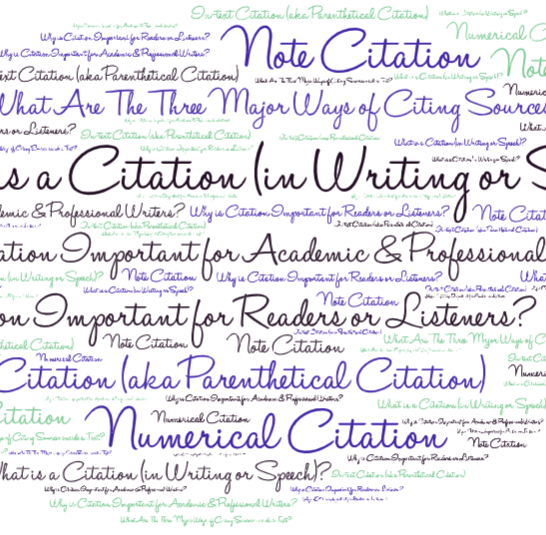
What is a Citation?
A “ citation ” refers to the act of integrating ideas or words from another source into your speech or writing , along with adhering to the specific discourse conventions (or standardized ways of acknowledging sources) in a particular academic or professional field . “Citations” are required in academic and professional writing when writers summarize , paraphrase , or quote the words or ideas others. Writers may also cite known experts to enhance the authority of their arguments and observations.
In both academic and professional settings, the practice of citing sources—whether through quotations , paraphrasing , or summarizing —is a fundamental mark of professionalism. Being capable of citing sources correctly and critiquing the citations of others is a basic literacy in a knowledge economy.
Most generally, “citation” refers to the act of crediting a source of information . While “citation” is the formal term, there are several colloquial synonyms that people might use interchangeably, such as “ attribution ,” “reference,” or “mention.” In more casual or conversational settings, phrases like “backing up” one’s claim or providing “proof” might be used. When writers or speakers incorporate information from an external source, they might say they are “citing,” “ attributing ,” or “referencing” that source.
Related Concepts: Academic Dishonesty ; Archive ; Authority in Academic Writing ; Canon ; Copyright ; Discourse ; Hermeneutics ; Information Has Value ; Intellectual Property ; Paraphrase ; Plagiarism ; Quotation ; Scholarship as a Conversation ; Summary
What Are The Three Major Ways of Citing Sources inside a Text?
While there are many different citation styles, as discussed below, there are only three major types of citations:
- In-text Citation (aka Parenthetical Citation)
- Numerical citation
- Note Citations
In-text Citation (aka Parenthetical Citation )
In-text Citation refers to the practice of placing bibliographical information in parentheses when sources/information are first introduced in a quote , paraphrase , or summary . The in-text citation is typically shorter and directs the reader to the full citation in the bibliography or reference list. In essence, all in-text citations are citations, but not all citations are in-text citations.
APA Example
When using APA style, writers place the author’s name, year, and page number (when available) in parentheses.
- “As of 2022, about 12,700 nuclear warheads are still estimated to be in use, of which more than 9,400 are in military stockpiles for use by missiles, aircraft, ships and submarines” (Eagle, 2022).
And then at the end of their text, they list all of the sources they cited in the text, providing all of the bibliographical information users need to track down the source and read it:
- Eagle, J. (2022, March 21). Animated chart: Nuclear warheads by country (1945-2022). Visual Capitalist .
Numerical Citation
Numerical Citation refers to when writers use numbers in brackets or superscript rather than parentheses to indicate to readers when they are quoting , paraphrasing , or summarizing :
IEEE Example
- “As of 2022, about 12,700 nuclear warheads are still estimated to be in use, of which more than 9,400 are in military stockpiles for use by missiles, aircraft, ships and submarines” [1]
Subsequently, in the reference list at the end of their text, writers provided the bibliographic information following the order of the citations in the text:
Chicago (Turabian) Example
- [1]J. Eagle, “Animated Chart: Nuclear Warheads by Country (1945-2022),” Visual Capitalist , Mar. 21, 2022. (accessed Jan. 03, 2023).
[ See Inclusive – Inclusive Language for a full-length example of Numerical Citations ]
Note Citation
Note Citations refers to when writers place citations numbers just as they do with numerical citations AND then provide all of the required bibliographical information in the text–as opposed to providing all that information at the end of the text in a list of references:
- “As of 2022, about 12,700 nuclear warheads are still estimated to be in use, of which more than 9,400 are in military stockpiles for use by missiles, aircraft, ships and submarines” J. Eagle, “Animated Chart: Nuclear Warheads by Country (1945-2022),” Visual Capitalist , Mar. 21, 2022. (accessed Jan. 03, 2023).

What Do All Citations Styles Have in Common?
Regardless of which citation style is used, attributions typically provide four types of bibliographical information :
- Name of Author(s)
- Title of source, whether it’s a book/article/website, etc
- Date of publication, if available
- Publisher information.
What Are the Most Popular Citation Styles?
Professional organizations (communities of practice) have unique ways of formatting citations. (See Wikipedia for a good listing of citation styles .)
Although style guides differ in regard to where the author’s name or publishing source is listed, they are all designed to ensure that proper credit is given to authors. As you know from your experience as a writer, developing insights and conducting original research is difficult and time consuming, so you can understand why people want to receive proper credit for their original ideas.
- MLA Handbook, 9th Edition Modern Language Association style is primarily used in the fields of English and foreign languages.
- Publication Manual of the APA: 7th Edition American Psychological Association’s style guide is used in psychology and education. Education and social science professors commonly ask students to follow the APA style for citing and documenting sources. APA differs from MLA in a number of ways, including the overall structure and format of the essay, but the major distinction between the two is APA’s use of the year of publication, rather than the page on which a particular quotation appears, for the in-text citation. APA requires in-text publication dates because of the particular importance of a study’s currency to research reports in the social sciences.
- Chicago Style is used in many social science fields.
- CSE (Council of Science Editors) is used by the scientific community
- IEEE (Institute of Electrical and Electronic Engineers) is used by the engineering community.
What Critical Perspectives Do Readers Use to Assess Your Citations?
Citation in speech and writing serves as a barometer of ethos , especially trustworthiness . When audiences are engaged in critical literacy practices , they are likely to question a source’s
When audiences check the archive and find that authors are making inconsistent quotations , they are likely to question the character or ethos of the author.
In other words, subject matter experts tend to be well versed in the ongoing conversations that characterize the works of other subject matter experts. Experienced researchers tend to engage in strategic searching of the archive . They engage in critical literacy practices , asking questions, such as
- What is the status of knowledge on the topic ?
- What is the ebb and flow of research on the topic –over time?
- What are the canonical texts ?
- Who are the pioneers? How has their work changed the conversation?
- What knowledge claims are currently being debated?
Related Articles:
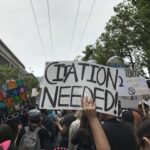
APA - Publication Manual of the APA: 7th Edition
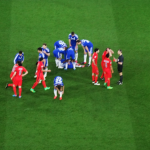
Attribution - What Is The Role of Attribution In Academic & Professional Writing?
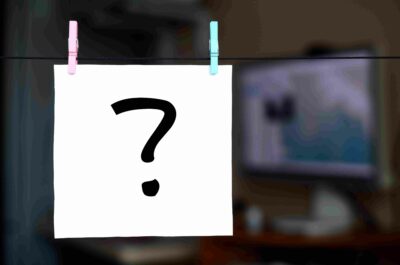
Citation Guide - Learn How to Cite Sources in Academic and Professional Writing
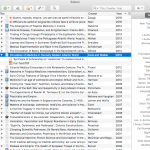
Citation Tools

MLA - MLA Handbook, 9th Edition
Suggested edits.
- Please select the purpose of your message. * - Corrections, Typos, or Edits Technical Support/Problems using the site Advertising with Writing Commons Copyright Issues I am contacting you about something else
- Your full name
- Your email address *
- Page URL needing edits *
- Name This field is for validation purposes and should be left unchanged.
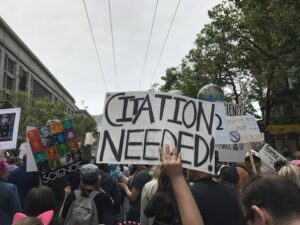
- Joseph M. Moxley
Attribution refers to the practice of crediting original sources for information or ideas. It encompasses recognizing authors, understanding their credentials, and correctly citing their work in your own speech and...
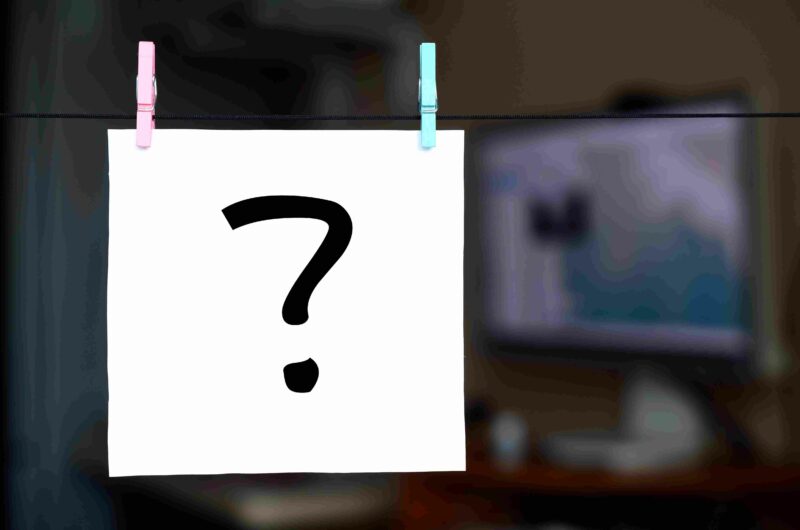
Citation isn’t just about adhering to prescribed rules or ensuring each dot and comma is in its rightful place. It’s a rhetorical, fluid, intuitive process where writers must balance the...
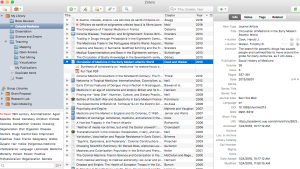
Citation Tools (aka bibliography tools or citation managers) are software tools that (1) facilitate the processes of finding, tagging, and annotating sources and (2) automate the formatting processes for citations...

Featured Articles

Academic Writing – How to Write for the Academic Community

Professional Writing – How to Write for the Professional World

Authority – How to Establish Credibility in Speech & Writing

Public Speaking and Interpersonal Communications
- Reference Resources
- Oral Citations
- First Amendment Assignment Resources
- Lesson 7 Persuasive Values Speech Resources
Basic Format for Oral Citations
Key Elements for Citing Sources in a Speech
WHO/WHAT: The source of the supporting material
- Name of publication
- Organization who created the information
- Author of the source and credentials of the author (if applicable)
- Name/credentials of the person interviewed
WHEN: State when the source was published, updated, and/or accessed (year/date)
Oral Citation Handouts
- Adding Oral Citations - EGCC Created by an EGCC professor, this handout reviews how to cite sources in a speech.
- Oral Citation Guide - James Madison University This handout from James Madison University gives examples and tips for oral citations.
How to Cite Different Resource Types
If you are citing information from a digital or print magazine, newspaper, or journal article, state the following:
- Full date (Month, year, and day if available)
- Title of the magazine, newspaper, or journal
- Often the name of the publication is enough, but if the author has qualifications that you'd like to share, you can include the author's name and credentials as well
You do NOT need to cite the page number or the name of the electronic database that you got the article from. You may want to cite the title of the article if it helps differentiate between multiple sources from the same magazine, newspaper, or journal.
Examples:
- “According to the New York Times , in an article from February 2, 2022…” “
- "In the October-December 2021 issue of Planning for Higher Education , Karen Merritt, director of academic planning at UC Merced, discusses how underfunding public universities can…”
- “In the most recent Gallup Poll, cited in the March 2022 issue of Time magazine…”
If you are citing information from a book, state the following:
- Year of publication
- A brief mention of the author's credentials
You do NOT need to cite the page number, publisher name, or city of publication.
- "In her 2018 book, Food and Public Health , Allison Karpyn, a professor of Human Development and Family Sciences at the University of Delaware, notes that…”
If you are citing information from an interview, state the following:
- The interviewee's name and statement of their credentials
- Date of interview (if available)
- The fact that the information is from a personal interview (if applicable)
- The source of the interview (if it is published in a journal, magazine, newspaper, etc.)
Please note: Interviews are not the same as informal discussions or class lectures. People being interviewed must be authoritative and credentialed “experts” in their fields.
- “In a personal interview on March 26, 2022, that I conducted with William P. Alford, Professor of Law at Harvard University, he stated that…"
- "In an interview with author Margaret Atwood, published in The Guardian on September 12, 2020, Atwood discusses..."
If you are citing information from a website, state the following:
- The name of the website
- The creator (author, organization, or sponsor) which supports the website’s credentials and authority
- The last date it was updated (if available)
- The date you accessed the site (if applicable)
You do NOT need to give the URL.
Please note: It is important to establish the credibility, currency, and objectivity (fact vs. opinion) of the website. You often can verify a website’s “credentials” by looking for links like: “About us” or “Our Mission” or “Who we are.” If you cannot find this information, you may want to consider using a different source. For more information about evaluating website information, please visit our Evaluating Information page.
- “According to the Association for College and Research Libraries' Equity, Diversity, and Inclusion website, last updated on April 1, 2020, some initiatives include..."
Helpful Videos
Oral Citation Tips
Advice for Oral Citations in a Speech
- Include your citation at the beginning of a sentence before you share the information, using phrases like: "According to...", "As reported by..." and "Based on research published in..."
- Oral citation takes place before the information
- Source and credentials are included
- Date / year published are included
- Do not say "quote, unquote" when you state a direct quotation. Pause briefly instead.
- << Previous: Reference Resources
- Next: First Amendment Assignment Resources >>
- Last Updated: Aug 28, 2023 2:45 PM
- URL: https://egcc.libguides.com/communications
Citing Sources
- Chicago/Turabian Style
- Verbal Citations
- MSU Guidelines
- Other Styles
- Citation Tools and Tutorials
- Ask A Librarian
Formal Citation List
In many cases, your speech should be accompanied by a formal citation list in addition to providing the verbal citation within the context of your speech. For your formal citation list, use the resources below to create citations in the designated citation style.
Handouts from Sprague Library, links to Excelsior University's Online Writing Lab, and more.
- Citing Sources (Montclair State University Center for Writing Excellence) A collection of resources and information on all major citation styles from the Center for Writing Excellence (CWE).
- APA Style Handout - Sprague Library
- APA Formatting & Style Guide - Excelsior OWL
- APA Style - American Psychological Association
- MLA Style Handout - Sprague Library
- MLA Formatting & Style Guide - Excelsior OWL
- Chicago Style Handout - Sprague Library
- Chicago Formatting & Style Guide - Excelsior OWL
- Chicago Manual of Style Online
- AMA Manual of Style: A Guide for Authors and Editors (11th Edition, eBook) Full manual of style, available online.
- AMA Citation Style (American Medical Association) - St. Catherine University
- Citing Sources Research Guide A guide to attributing sources in footnotes, in-text citations & bibliographies
- EndNote Online Register for an account through EndNote Online. Please use your Montclair State University e-mail address for verification purposes.
How to make a verbal citation
Citing sources verbally in a speech works similarly to how journalists cite sources in magazine and newspaper article. In both cases, you need to provide both the citation and the context to help your audience understand the authority of the source.
General guidelines
Be brief, but provide enough information that your audience can track down the source. Highlight what is most important criteria for that source. Include who,what, when, and why the source is credible.
Use a combination of two or more of the following to verbally cite a source and relay credibility to your audience:
- Author's credentials
- Title of Work
- Title of Publication
- Date of work/publication/study
What not to do
Examples of verbal citations.
- "Black to the Future"
- "Who You Callin' Hysterical?"
- "An Oratory"
- "Life, Liberty, and the Pursuit of Purpose"
- "Sizing Up Our Fashion Footprint"
- << Previous: AMA Style
- Next: Books >>
- Last Updated: Feb 14, 2024 11:03 AM
- URL: https://montclair.libguides.com/citing

The Plagiarism Checker Online For Your Academic Work
Start Plagiarism Check
Editing & Proofreading for Your Research Paper
Get it proofread now
Online Printing & Binding with Free Express Delivery
Configure binding now
- Academic essay overview
- The writing process
- Structuring academic essays
- Types of academic essays
- Academic writing overview
- Sentence structure
- Academic writing process
- Improving your academic writing
- Titles and headings
- APA style overview
- APA citation & referencing
- APA structure & sections
- Citation & referencing
- Structure and sections
- APA examples overview
- Commonly used citations
- Other examples
- British English vs. American English
- Chicago style overview
- Chicago citation & referencing
- Chicago structure & sections
- Chicago style examples
- Citing sources overview
- Citation format
- Citation examples
- College essay overview
- Application
- How to write a college essay
- Types of college essays
- Commonly confused words
- Definitions
- Dissertation overview
- Dissertation structure & sections
- Dissertation writing process
- Graduate school overview
- Application & admission
- Study abroad
- Master degree
- Harvard referencing overview
- Language rules overview
- Grammatical rules & structures
- Parts of speech
- Punctuation
- Methodology overview
- Analyzing data
- Experiments
- Observations
- Inductive vs. Deductive
- Qualitative vs. Quantitative
- Types of validity
- Types of reliability
- Sampling methods
- Theories & Concepts
- Types of research studies
- Types of variables
- MLA style overview
- MLA examples
- MLA citation & referencing
- MLA structure & sections
- Plagiarism overview
- Plagiarism checker
- Types of plagiarism
- Printing production overview
- Research bias overview
- Types of research bias
- Example sections
- Types of research papers
- Research process overview
- Problem statement
- Research proposal
- Research topic
- Statistics overview
- Levels of measurment
- Frequency distribution
- Measures of central tendency
- Measures of variability
- Hypothesis testing
- Parameters & test statistics
- Types of distributions
- Correlation
- Effect size
- Hypothesis testing assumptions
- Types of ANOVAs
- Types of chi-square
- Statistical data
- Statistical models
- Spelling mistakes
- Tips overview
- Academic writing tips
- Dissertation tips
- Sources tips
- Working with sources overview
- Evaluating sources
- Finding sources
- Including sources
- Types of sources
Your Step to Success
Plagiarism Check within 10min
Printing & Binding with 3D Live Preview
APA Speech Citation – A Comprehensive Guide
How do you like this article cancel reply.
Save my name, email, and website in this browser for the next time I comment.
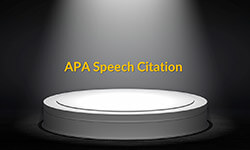
Providing proper credit and avoiding plagiarism is essential when writing academic papers. Citing sources correctly is crucial in academic writing to effectively convey your arguments and keep up academic integrity. This article offers a comprehensive guide to APA speech citations, which includes definitions, how to format an APA speech citation with examples, and answers to frequently asked questions.
Inhaltsverzeichnis
- 1 In a nutshell: APA speech citation
- 2 Definition: APA speech citation
- 3 In-text citation
- 4 Reference entry
- 5 Examples of APA speech citation
In a nutshell: APA speech citation
- It is important to use proper APA citation when referencing speeches to avoid plagiarism and give proper credit to the original speaker.
- Speaker’s name
- Speech title (if applicable)
- Location (where the speech was delivered)
- The format for citing a speech may vary depending on whether it is directly quoted within the text or listed as a reference at the end of the paper.
- The dates are used to differentiate between multiple speeches given by the same speaker.
Definition: APA speech citation
APA speech citation is a reference to a speech, lecture, or public address that you’ve used as a source in your research paper. It follows the guidelines established by the American Psychological Association (APA) for citing sources in academic papers.
You can take a look at an overview of all our APA examples in this article.
In-text citation
According to the APA style , when you’re citing a speech in-text, you should include the:
- Speaker’s last name
- Year of the speech
If you’re directly quoting the speech, you also include the timestamp in minutes and seconds.
Reference entry
When you’re citing a speech in the reference list at the end of your paper, you should include the:
- Speech’s year
- Title (if any)
Here’s the general format:
(Speaker’s Last name, Year, Timestamp)
Speaker’s Last name, First initials. (Year, Month Day). Title of speech [Type of speech]. Location.
Examples of APA speech citation
Let’s illustrate the APA speech citation with a hypothetical example.
- In-text citation: King, M. L. Jr. (1963) said, “I have a dream” (15:45).
- Reference list citation: King, M. L. Jr. (1963, August 28). I Have a Dream [Speech transcript]. Lincoln Memorial, Washington D.C.
What if the speech doesn't have a title?
If the speech doesn’t have a specific title, you can describe the speech in square brackets.
For instance, [Inaugural address].
How to cite a recorded speech?
If the speech is from a recorded source like YouTube, include the URL in the citation.
King, M. L. Jr. (1963, August 28). I Have a Dream [Speech transcript]. Lincoln Memorial, Washington D.C. Retrieved from URL
Can I cite a speech I attended personally?
Yes, you can. If the speech is not retrievable by the reader (e.g., a private lecture or a keynote address), you’d consider it as “personal communication,” which is cited in-text but not in the reference list.
We use cookies on our website. Some of them are essential, while others help us to improve this website and your experience.
- External Media
Individual Privacy Preferences
Cookie Details Privacy Policy Imprint
Here you will find an overview of all cookies used. You can give your consent to whole categories or display further information and select certain cookies.
Accept all Save
Essential cookies enable basic functions and are necessary for the proper function of the website.
Show Cookie Information Hide Cookie Information
Statistics cookies collect information anonymously. This information helps us to understand how our visitors use our website.
Content from video platforms and social media platforms is blocked by default. If External Media cookies are accepted, access to those contents no longer requires manual consent.
Privacy Policy Imprint


Definition of 'citation'

citation in British English
Citation in american english, examples of 'citation' in a sentence citation, cobuild collocations citation, trends of citation.
View usage for: All Years Last 10 years Last 50 years Last 100 years Last 300 years
In other languages citation
- American English : citation / saɪˈteɪʃən /
- Brazilian Portuguese : menção
- Chinese : 嘉奖
- European Spanish : mención
- French : citation
- German : Belobigung
- Italian : citazione
- Japanese : 表彰
- Korean : 표창장
- European Portuguese : menção
- Latin American Spanish : mención
- Thai : ใบประกาศเกียรติคุณ, คำสดุดี
Browse alphabetically citation
- citation form
- citation reads
- All ENGLISH words that begin with 'C'
Related terms of citation
- award citation
- issue a citation
Quick word challenge
Quiz Review
Score: 0 / 5

Wordle Helper

Scrabble Tools


- school Campus Bookshelves
- menu_book Bookshelves
- perm_media Learning Objects
- login Login
- how_to_reg Request Instructor Account
- hub Instructor Commons
- Download Page (PDF)
- Download Full Book (PDF)
- Periodic Table
- Physics Constants
- Scientific Calculator
- Reference & Cite
- Tools expand_more
- Readability
selected template will load here
This action is not available.

7.3: Citing Sources
- Last updated
- Save as PDF
- Page ID 63566

Learning Objectives
- Understand what style is.
- Know which academic disciplines you are more likely to use, American Psychological Association (APA) versus Modern Language Association (MLA) style.
- Cite sources using the sixth edition of the American Psychological Association’s Style Manual.
- Cite sources using the seventh edition of the Modern Language Association’s Style Manual.
- Explain the steps for citing sources within a speech.
- Differentiate between direct quotations and paraphrases of information within a speech.
- Understand how to use sources ethically in a speech.
- Explain twelve strategies for avoiding plagiarism.
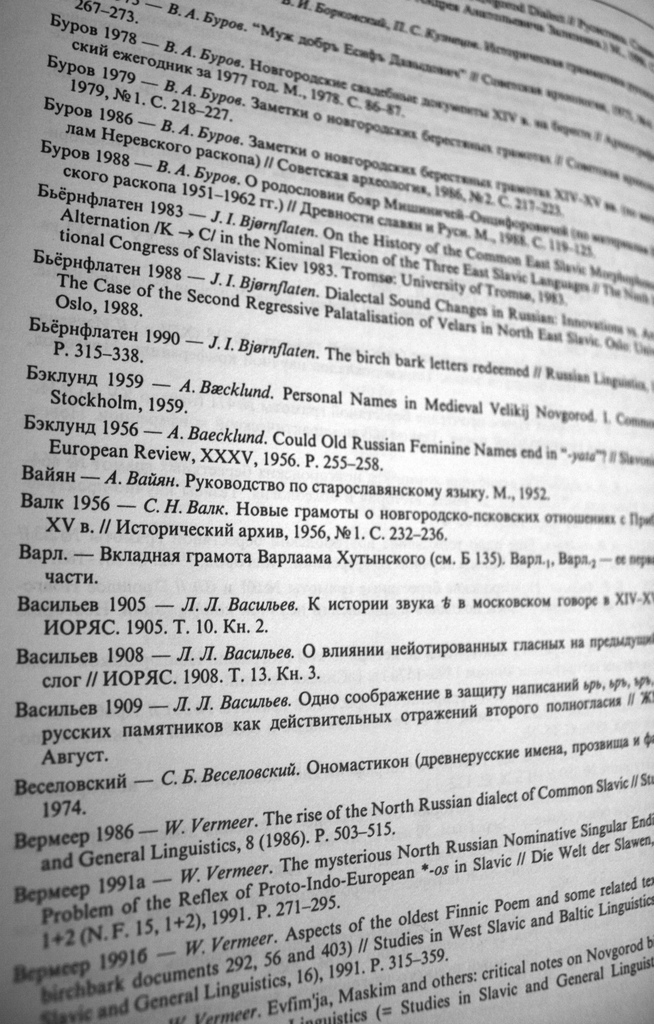
Quinn Dombrowski – Bilbiography – CC BY-SA 2.0.
By this point you’re probably exhausted after looking at countless sources, but there’s still a lot of work that needs to be done. Most public speaking teachers will require you to turn in either a bibliography or a reference page with your speeches. In this section, we’re going to explore how to properly cite your sources for a Modern Language Association (MLA) list of works cited or an American Psychological Association (APA) reference list. We’re also going to discuss plagiarism and how to avoid it.
Why Citing Is Important
Citing is important because it enables readers to see where you found information cited within a speech, article, or book. Furthermore, not citing information properly is considered plagiarism, so ethically we want to make sure that we give credit to the authors we use in a speech. While there are numerous citation styles to choose from, the two most common style choices for public speaking are APA and MLA.
APA versus MLA Source Citations
Style refers to those components or features of a literary composition or oral presentation that have to do with the form of expression rather than the content expressed (e.g., language, punctuation, parenthetical citations, and endnotes). The APA and the MLA have created the two most commonly used style guides in academia today. Generally speaking, scholars in the various social science fields (e.g., psychology, human communication, business) are more likely to use APA style , and scholars in the various humanities fields (e.g., English, philosophy, rhetoric) are more likely to use MLA style . The two styles are quite different from each other, so learning them does take time.
APA Citations
The first common reference style your teacher may ask for is APA. As of July 2009, the American Psychological Association published the sixth edition of the Publication Manual of the American Psychological Association ( http://www.apastyle.org ) (American Psychological Association, 2010). The sixth edition provides considerable guidance on working with and citing Internet sources. Table 7.4 “APA Sixth Edition Citations” provides a list of common citation examples that you may need for your speech.
Table 7.4 APA Sixth Edition Citations
MLA Citations
The second common reference style your teacher may ask for is MLA. In March 2009, the Modern Language Association published the seventh edition of the MLA Handbook for Writers of Research Papers (Modern Language Association, 2009) (www.mla.org/style). The seventh edition provides considerable guidance for citing online sources and new media such as graphic narratives. Table 7.5 “MLA Seventh Edition Citations” provides a list of common citations you may need for your speech.
Table 7.5 MLA Seventh Edition Citations
Citing Sources in a Speech
Once you have decided what sources best help you explain important terms and ideas in your speech or help you build your arguments, it’s time to place them into your speech. In this section, we’re going to quickly talk about using your research effectively within your speeches. Citing sources within a speech is a three-step process: set up the citation, give the citation, and explain the citation.
First, you want to set up your audience for the citation. The setup is one or two sentences that are general statements that lead to the specific information you are going to discuss from your source. Here’s an example: “Workplace bullying is becoming an increasing problem for US organizations.” Notice that this statement doesn’t provide a specific citation yet, but the statement introduces the basic topic.
Second, you want to deliver the source; whether it is a direct quotation or a paraphrase of information from a source doesn’t matter at this point. A direct quotation is when you cite the actual words from a source with no changes. To paraphrase is to take a source’s basic idea and condense it using your own words. Here’s an example of both:
You’ll notice that in both of these cases, we started by citing the author of the study—in this case, the Workplace Bullying Institute. We then provided the title of the study. You could also provide the name of the article, book, podcast, movie, or other source. In the direct quotation example, we took information right from the report. In the second example, we summarized the same information (Workplace Bullying Institute, 2009).
Let’s look at another example of direct quotations and paraphrases, this time using a person, rather than an institution, as the author.
Notice that the same basic pattern for citing sources was followed in both cases.
The final step in correct source citation within a speech is the explanation. One of the biggest mistakes of novice public speakers (and research writers) is that they include a source citation and then do nothing with the citation at all. Instead, take the time to explain the quotation or paraphrase to put into the context of your speech. Do not let your audience draw their own conclusions about the quotation or paraphrase. Instead, help them make the connections you want them to make. Here are two examples using the examples above:
Notice how in both of our explanations we took the source’s information and then added to the information to direct it for our specific purpose. In the case of the bullying citation, we then propose that businesses should either adopt workplace bullying guidelines or face legal intervention. In the case of the “aha!” example, we turn the quotation into a section on helping people find their thesis or topic. In both cases, we were able to use the information to further our speech.
Using Sources Ethically
The last section of this chapter is about using sources in an ethical manner. Whether you are using primary or secondary research, there are five basic ethical issues you need to consider.
Avoid Plagiarism
First, and foremost, if the idea isn’t yours, you need to cite where the information came from during your speech. Having the citation listed on a bibliography or reference page is only half of the correct citation. You must provide correct citations for all your sources within the speech as well. In a very helpful book called Avoiding Plagiarism: A Student Guide to Writing Your Own Work , Menager-Beeley and Paulos provide a list of twelve strategies for avoiding plagiarism (Menager-Beeley & Paulos, 2009):
- Do your own work, and use your own words. One of the goals of a public speaking class is to develop skills that you’ll use in the world outside academia. When you are in the workplace and the “real world,” you’ll be expected to think for yourself, so you might as well start learning this skill now.
- Allow yourself enough time to research the assignment. One of the most commonly cited excuses students give for plagiarism is that they didn’t have enough time to do the research. In this chapter, we’ve stressed the necessity of giving yourself plenty of time. The more complete your research strategy is from the very beginning, the more successful your research endeavors will be in the long run. Remember, not having adequate time to prepare is no excuse for plagiarism.
- Keep careful track of your sources. A common mistake that people can make is that they forget where information came from when they start creating the speech itself. Chances are you’re going to look at dozens of sources when preparing your speech, and it is very easy to suddenly find yourself believing that a piece of information is “common knowledge” and not citing that information within a speech. When you keep track of your sources, you’re less likely to inadvertently lose sources and not cite them correctly.
- Take careful notes. However you decide to keep track of the information you collect (old-fashioned pen and notebook or a computer software program), the more careful your note-taking is, the less likely you’ll find yourself inadvertently not citing information or citing the information incorrectly. It doesn’t matter what method you choose for taking research notes, but whatever you do, you need to be systematic to avoid plagiarizing.
- Assemble your thoughts, and make it clear who is speaking. When creating your speech, you need to make sure that you clearly differentiate your voice in the speech from the voice of specific authors of the sources you quote. The easiest way to do this is to set up a direct quotation or a paraphrase, as we’ve described in the preceding sections. Remember, audience members cannot see where the quotation marks are located within your speech text, so you need to clearly articulate with words and vocal tone when you are using someone else’s ideas within your speech.
- If you use an idea, a quotation, paraphrase, or summary, then credit the source. We can’t reiterate it enough: if it is not your idea, you need to tell your audience where the information came from. Giving credit is especially important when your speech includes a statistic, an original theory, or a fact that is not common knowledge.
- Learn how to cite sources correctly both in the body of your paper and in your List of Works Cited ( Reference Page ) . Most public speaking teachers will require that you turn in either a bibliography or reference page on the day you deliver a speech. Many students make the mistake of thinking that the bibliography or reference page is all they need to cite information, and then they don’t cite any of the material within the speech itself. A bibliography or reference page enables a reader or listener to find those sources after the fact, but you must also correctly cite those sources within the speech itself; otherwise, you are plagiarizing.
- Quote accurately and sparingly. A public speech should be based on factual information and references, but it shouldn’t be a string of direct quotations strung together. Experts recommend that no more than 10 percent of a paper or speech be direct quotations (Menager-Beeley & Paulos, 2009). When selecting direct quotations, always ask yourself if the material could be paraphrased in a manner that would make it clearer for your audience. If the author wrote a sentence in a way that is just perfect, and you don’t want to tamper with it, then by all means directly quote the sentence. But if you’re just quoting because it’s easier than putting the ideas into your own words, this is not a legitimate reason for including direct quotations.
- Paraphrase carefully. Modifying an author’s words in this way is not simply a matter of replacing some of the words with synonyms. Instead, as Howard and Taggart explain in Research Matters , “paraphrasing force[s] you to understand your sources and to capture their meaning accurately in original words and sentences” (Howard & Taggart, 2010). Incorrect paraphrasing is one of the most common forms of inadvertent plagiarism by students. First and foremost, paraphrasing is putting the author’s argument, intent, or ideas into your own words.
- Do not patchwrite ( patchspeak ) . Menager-Beeley and Paulos define patchwriting as consisting “of mixing several references together and arranging paraphrases and quotations to constitute much of the paper. In essence, the student has assembled others’ work with a bit of embroidery here and there but with little original thinking or expression” (Menager-Beeley & Paulos, 2009). Just as students can patchwrite, they can also engage in patchspeaking. In patchspeaking, students rely completely on taking quotations and paraphrases and weaving them together in a manner that is devoid of the student’s original thinking.
- Summarize, don’t auto-summarize. Some students have learned that most word processing features have an auto-summary function. The auto-summary function will take a ten-page document and summarize the information into a short paragraph. When someone uses the auto-summary function, the words that remain in the summary are still those of the original author, so this is not an ethical form of paraphrasing.
- Do not rework another student’s paper ( speech ) or buy paper mill papers ( speech mill speeches ) . In today’s Internet environment, there are a number of storehouses of student speeches on the Internet. Some of these speeches are freely available, while other websites charge money for getting access to one of their canned speeches. Whether you use a speech that is freely available or pay money for a speech, you are engaging in plagiarism. This is also true if the main substance of your speech was copied from a web page. Any time you try to present someone else’s ideas as your own during a speech, you are plagiarizing.
Avoid Academic Fraud
While there are numerous websites where you can download free speeches for your class, this is tantamount to fraud. If you didn’t do the research and write your own speech, then you are fraudulently trying to pass off someone else’s work as your own. In addition to being unethical, many institutions have student codes that forbid such activity. Penalties for academic fraud can be as severe as suspension or expulsion from your institution.
Don’t Mislead Your Audience
If you know a source is clearly biased, and you don’t spell this out for your audience, then you are purposefully trying to mislead or manipulate your audience. Instead, if the information may be biased, tell your audience that the information may be biased and allow your audience to decide whether to accept or disregard the information.
Give Author Credentials
You should always provide the author’s credentials. In a world where anyone can say anything and have it published on the Internet or even publish it in a book, we have to be skeptical of the information we see and hear. For this reason, it’s very important to provide your audience with background about the credentials of the authors you cite.
Use Primary Research Ethically
Lastly, if you are using primary research within your speech, you need to use it ethically as well. For example, if you tell your survey participants that the research is anonymous or confidential, then you need to make sure that you maintain their anonymity or confidentiality when you present those results. Furthermore, you also need to be respectful if someone says something is “off the record” during an interview. We must always maintain the privacy and confidentiality of participants during primary research, unless we have their express permission to reveal their names or other identifying information.
Key Takeaways
- Style focuses on the components of your speech that make up the form of your expression rather than your content.
- Social science disciplines, such as psychology, human communication, and business, typically use APA style, while humanities disciplines, such as English, philosophy, and rhetoric, typically use MLA style.
- The APA sixth edition and the MLA seventh edition are the most current style guides and the tables presented in this chapter provide specific examples of common citations for each of these styles.
- Citing sources within your speech is a three-step process: set up the citation, provide the cited information, and interpret the information within the context of your speech.
- A direct quotation is any time you utilize another individual’s words in a format that resembles the way they were originally said or written. On the other hand, a paraphrase is when you take someone’s ideas and restate them using your own words to convey the intended meaning.
- Ethically using sources means avoiding plagiarism, not engaging in academic fraud, making sure not to mislead your audience, providing credentials for your sources so the audience can make judgments about the material, and using primary research in ways that protect the identity of participants.
- Plagiarism is a huge problem and creeps its way into student writing and oral presentations. As ethical communicators, we must always give credit for the information we convey in our writing and our speeches.
- List what you think are the benefits of APA style and the benefits of MLA style. Why do you think some people prefer APA style over MLA style or vice versa?
- Find a direct quotation within a magazine article. Paraphrase that direct quotation. Then attempt to paraphrase the entire article as well. How would you cite each of these orally within the body of your speech?
- Which of Menager-Beeley and Paulos (2009) twelve strategies for avoiding plagiarism do you think you need the most help with right now? Why? What can you do to overcome and avoid that pitfall?
American Psychological Association. (2010). Publication manual of the American Psychological Association (6th ed.). Washington, DC: Author. See also American Psychological Association. (2010). Concise rules of APA Style: The official pocket style guide from the American Psychological Association (6th ed.). Washington, DC: Author.
Howard, R. M., & Taggart, A. R. (2010). Research matters . New York, NY: McGraw-Hill, p. 131.
Menager-Beeley, R., & Paulos, L. (2009). Understanding plagiarism: A student guide to writing your own work . Boston, MA: Houghton Mifflin Harcourt, pp. 5–8.
Modern Language Association. (2009). MLA handbook for writers of research papers (7th ed.). New York, NY: Modern Language Association.
Workplace Bullying Institute. (2009). Bullying: Getting away with it WBI Labor Day Study—September, 2009. Retrieved July 14, 2011, from http://www.workplacebullying.org/res/WBI2009-B-Survey.html
Purdue Online Writing Lab Purdue OWL® College of Liberal Arts
In-Text Citations: The Basics

Welcome to the Purdue OWL
This page is brought to you by the OWL at Purdue University. When printing this page, you must include the entire legal notice.
Copyright ©1995-2018 by The Writing Lab & The OWL at Purdue and Purdue University. All rights reserved. This material may not be published, reproduced, broadcast, rewritten, or redistributed without permission. Use of this site constitutes acceptance of our terms and conditions of fair use.
Note: This page reflects the latest version of the APA Publication Manual (i.e., APA 7), which released in October 2019. The equivalent resource for the older APA 6 style can be found here .
Reference citations in text are covered on pages 261-268 of the Publication Manual. What follows are some general guidelines for referring to the works of others in your essay.
Note: On pages 117-118, the Publication Manual suggests that authors of research papers should use the past tense or present perfect tense for signal phrases that occur in the literature review and procedure descriptions (for example, Jones (1998) found or Jones (1998) has found ...). Contexts other than traditionally-structured research writing may permit the simple present tense (for example, Jones (1998) finds ).
APA Citation Basics
When using APA format, follow the author-date method of in-text citation. This means that the author's last name and the year of publication for the source should appear in the text, like, for example, (Jones, 1998). One complete reference for each source should appear in the reference list at the end of the paper.
If you are referring to an idea from another work but NOT directly quoting the material, or making reference to an entire book, article or other work, you only have to make reference to the author and year of publication and not the page number in your in-text reference.
On the other hand, if you are directly quoting or borrowing from another work, you should include the page number at the end of the parenthetical citation. Use the abbreviation “p.” (for one page) or “pp.” (for multiple pages) before listing the page number(s). Use an en dash for page ranges. For example, you might write (Jones, 1998, p. 199) or (Jones, 1998, pp. 199–201). This information is reiterated below.
Regardless of how they are referenced, all sources that are cited in the text must appear in the reference list at the end of the paper.
In-text citation capitalization, quotes, and italics/underlining
- Always capitalize proper nouns, including author names and initials: D. Jones.
- If you refer to the title of a source within your paper, capitalize all words that are four letters long or greater within the title of a source: Permanence and Change . Exceptions apply to short words that are verbs, nouns, pronouns, adjectives, and adverbs: Writing New Media , There Is Nothing Left to Lose .
( Note: in your References list, only the first word of a title will be capitalized: Writing new media .)
- When capitalizing titles, capitalize both words in a hyphenated compound word: Natural-Born Cyborgs .
- Capitalize the first word after a dash or colon: "Defining Film Rhetoric: The Case of Hitchcock's Vertigo ."
- If the title of the work is italicized in your reference list, italicize it and use title case capitalization in the text: The Closing of the American Mind ; The Wizard of Oz ; Friends .
- If the title of the work is not italicized in your reference list, use double quotation marks and title case capitalization (even though the reference list uses sentence case): "Multimedia Narration: Constructing Possible Worlds;" "The One Where Chandler Can't Cry."
Short quotations
If you are directly quoting from a work, you will need to include the author, year of publication, and page number for the reference (preceded by "p." for a single page and “pp.” for a span of multiple pages, with the page numbers separated by an en dash).
You can introduce the quotation with a signal phrase that includes the author's last name followed by the date of publication in parentheses.
If you do not include the author’s name in the text of the sentence, place the author's last name, the year of publication, and the page number in parentheses after the quotation.
Long quotations
Place direct quotations that are 40 words or longer in a free-standing block of typewritten lines and omit quotation marks. Start the quotation on a new line, indented 1/2 inch from the left margin, i.e., in the same place you would begin a new paragraph. Type the entire quotation on the new margin, and indent the first line of any subsequent paragraph within the quotation 1/2 inch from the new margin. Maintain double-spacing throughout, but do not add an extra blank line before or after it. The parenthetical citation should come after the closing punctuation mark.
Because block quotation formatting is difficult for us to replicate in the OWL's content management system, we have simply provided a screenshot of a generic example below.

Formatting example for block quotations in APA 7 style.
Quotations from sources without pages
Direct quotations from sources that do not contain pages should not reference a page number. Instead, you may reference another logical identifying element: a paragraph, a chapter number, a section number, a table number, or something else. Older works (like religious texts) can also incorporate special location identifiers like verse numbers. In short: pick a substitute for page numbers that makes sense for your source.
Summary or paraphrase
If you are paraphrasing an idea from another work, you only have to make reference to the author and year of publication in your in-text reference and may omit the page numbers. APA guidelines, however, do encourage including a page range for a summary or paraphrase when it will help the reader find the information in a longer work.
- More from M-W
- To save this word, you'll need to log in. Log In
Definition of citation
- commendation
encomium , eulogy , panegyric , tribute , citation mean a formal expression of praise.
encomium implies enthusiasm and warmth in praising a person or a thing.
eulogy applies to a prepared speech or writing extolling the virtues and services of a person.
panegyric suggests an elaborate often poetic compliment.
tribute implies deeply felt praise conveyed either through words or through a significant act.
citation applies to the formal praise of a person offered in a military dispatch or in awarding an honorary degree.
Examples of citation in a Sentence
These examples are programmatically compiled from various online sources to illustrate current usage of the word 'citation.' Any opinions expressed in the examples do not represent those of Merriam-Webster or its editors. Send us feedback about these examples.
Word History
14th century, in the meaning defined at sense 1
Articles Related to citation
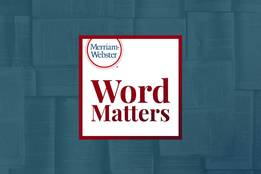
Inside Our Citation Files
Episode 72: Inside Our Citation Files
Dictionary Entries Near citation
citation form
Cite this Entry
“Citation.” Merriam-Webster.com Dictionary , Merriam-Webster, https://www.merriam-webster.com/dictionary/citation. Accessed 24 Apr. 2024.
Kids Definition
Kids definition of citation, legal definition, legal definition of citation.
Note: Citations are issued in minor criminal cases as an alternative to arrest. Often a person may consent in writing to the penalty specified on the citation and forgo an appearance in court.
More from Merriam-Webster on citation
Nglish: Translation of citation for Spanish Speakers
Britannica English: Translation of citation for Arabic Speakers
Britannica.com: Encyclopedia article about citation
Subscribe to America's largest dictionary and get thousands more definitions and advanced search—ad free!

Can you solve 4 words at once?
Word of the day.
See Definitions and Examples »
Get Word of the Day daily email!
Popular in Grammar & Usage
More commonly misspelled words, commonly misspelled words, how to use em dashes (—), en dashes (–) , and hyphens (-), absent letters that are heard anyway, how to use accents and diacritical marks, popular in wordplay, the words of the week - apr. 19, 10 words from taylor swift songs (merriam's version), 9 superb owl words, 10 words for lesser-known games and sports, your favorite band is in the dictionary, games & quizzes.

- Cambridge Dictionary +Plus
Meaning of citation in English
Your browser doesn't support HTML5 audio
citation noun [C] ( EXAMPLE )
- allude to someone / something
- allusiveness
- as for someone/something idiom
- bandy something around
- quote ... unquote idiom
- refer to someone/something
- reported speech
- undermentioned
citation noun [C] ( NAME )
- abatement order
- ambulance-chasing
- appear for someone
- bring an action
- complainant
- legal action
- prosecution
- prosecutorial
- reindictment
citation noun [C] ( PRAISE )
- acclamation
- enthronement
- eulogistically
- ooh and aah idiom
- overpraised
citation | American Dictionary
Citation noun ( mention ), citation noun ( praise ), examples of citation, translations of citation.
Get a quick, free translation!

Word of the Day
the fact that people or animals do what they are told to do

Dead ringers and peas in pods (Talking about similarities, Part 2)

Learn more with +Plus
- Recent and Recommended {{#preferredDictionaries}} {{name}} {{/preferredDictionaries}}
- Definitions Clear explanations of natural written and spoken English English Learner’s Dictionary Essential British English Essential American English
- Grammar and thesaurus Usage explanations of natural written and spoken English Grammar Thesaurus
- Pronunciation British and American pronunciations with audio English Pronunciation
- English–Chinese (Simplified) Chinese (Simplified)–English
- English–Chinese (Traditional) Chinese (Traditional)–English
- English–Dutch Dutch–English
- English–French French–English
- English–German German–English
- English–Indonesian Indonesian–English
- English–Italian Italian–English
- English–Japanese Japanese–English
- English–Norwegian Norwegian–English
- English–Polish Polish–English
- English–Portuguese Portuguese–English
- English–Spanish Spanish–English
- English–Swedish Swedish–English
- Dictionary +Plus Word Lists
- citation (EXAMPLE)
- citation (NAME)
- citation (PRAISE)
- citation (MENTION)
- Translations
- All translations
Add citation to one of your lists below, or create a new one.
{{message}}
Something went wrong.
There was a problem sending your report.
Having remade Twitter, Elon Musk takes his speech fight global
The x owner has become a bridge between american conservatives and the global far right.
SAN FRANCISCO — To Elon Musk, the Brazilian Supreme Court justice is a “dictator.”
In the justice’s view, Musk is allowing his social media platform to support the “digital militias” that are using disinformation to threaten democracy.
Together, they’re making this South American nation the battleground for the global debate on free speech and fake news, a dispute that could affect how people everywhere communicate information, ideas and opinions online.
On one side, there’s Alexandre de Moraes, one of the world’s most aggressive prosecutors of disinformation. In recent years, as right-wing Brazilian leader Jair Bolsonaro and his supporters questioned the integrity of Brazil’s elections, Moraes was granted expanded powers to fight false claims online. As head of the country’s top elections court, he has issued arrest warrants against dozens of figures and demanded that social media companies take down scores of accounts.
Then there’s Musk, the combative tech billionaire who, since taking over Twitter, has loosened the platform’s restrictions on hateful content and allowed misinformation to flood the platform in the name of free speech.
Their opposing worldviews exploded into public view this month, when Musk announced he would no longer countenance judicial orders from Moraes, who he said was breaking Brazilian law, and threatened to shutter the platform, now called X, in one of its most active markets.
Moraes, in response, said he was adding Musk as a target in his ongoing criminal investigation into political groups accused of using false information to attack democracy.
Musk did not respond to a request for comment. Moraes declined to comment.
The dispute could influence how social media platforms police their users in countries that regulate free speech differently than the United States. And it’s cementing Musk’s rise as an avatar of the global right, where he’s found common ground with some of its most prominent and polarizing figures.
Since declaring his independence from Moraes’s orders, Musk has met with Argentine President Javier Milei at a Tesla factory in Texas, been invited to a live online appearance with Bolsonaro and said he will meet soon with Indian Prime Minister Narendra Modi. All are populists bolstered by online armies that have been accused of spreading disinformation.
Musk has spent the past week interacting online with conservative Brazilians whose accounts have been banned by Moraes — a group that has long sought his attention. In the United States, meanwhile, congressional Republicans, who have long sparred with tech giants over online censorship, have subpoenaed X’s records related to its operations in Brazil.
Musk’s politics form “a connective tissue between these far-right figures and movements,” said Emerson Brooking, a disinformation researcher with the Digital Forensic Research Lab of the Atlantic Council. “He is globalizing America’s culture wars.”
Over the weekend, X walked back Musk’s challenge, telling the court in a letter it would continue to comply with all of its orders, according to a copy obtained by The Washington Post.
Musk has not commented publicly on the reversal. X declined to comment.
Musk remains a target of Moraes’s investigation, according to a Supreme Court official, who spoke on the condition of anonymity under rules set by the court. That probe goes beyond X’s content moderation policies into whether Musk is part of an organized threat to the country’s democracy.
Differing definitions of free speech
In Brazil, Latin America’s largest democracy, internet users spend an average of more than nine hours a day online, according to the market research firm Kepios. They enjoy freedom of expression, but it’s not an absolute right.
In the United States, the First Amendment guarantees Americans wide latitude to speak publicly. In Brazil, hate speech and using disinformation to attack people or democracy are crimes.
Bolsonaro and his supporters have strained those limits with misinformation about the coronavirus , unfounded allegations against the electoral system and digital invective. Many who have posted such material have come under investigation by Moraes.
The judge ordered one blogger arrested for allegedly spreading anti-democratic ideas and committing crimes against honor. He ordered the arrest and censure of a federal congressman for calling for a new AI-5, a notorious decree from Brazil’s 20th-century dictatorship that curtailed political freedoms and consolidated the military’s hold on power.
People who have had their social media accounts blocked have also had assets frozen — sometimes, they say, with no explanation of what they did wrong. As a consequence, some have relocated to the United States.
These efforts have drawn criticism not only from the right, but also from tech companies and advocates for free speech. Musk says Moraes has gone too far.
Rolling back the rules
Twitter once enjoyed a reputation for fighting harder than others against demands by foreign governments to censor domestic activists and dissidents. It sued India and Turkey to protect content that was critical of their leaders.
In the United States, the company policed content on coronavirus misinformation and election falsehoods.
But when Musk bought the company in the fall of 2022, he argued that any content should be permitted unless it was expressly illegal. In his first months as chief executive, he rolled back rules against misinformation and restored thousands of banned accounts.
He also began taking steps, including charging for verification and engaging certain users, that have had the effect of boosting the visibility of conservative and right-wing accounts.
The platform’s record since then has been mixed . On the eve of Turkish elections last year, X complied with the demand of President Recep Tayyip Erdogan to restrict accounts. The company reportedly blocked the accounts of more than 100 activists and journalists at the Indian government’s request.
“Musk’s X is willing to comply and censor people much more than Twitter ever did,” Brooking said. In Brazil, “Musk has found a cause that lets him articulate his twisted vision of free speech: Not free speech for democratic activists, or for regular people, but for people who share his politics.”
‘Why are you doing this …?’
Moraes wasn’t always a villain to the Brazilian right. He was appointed to the Supreme Court in 2017 by conservative President Michel Temer.
But in a country haunted by the military dictatorship of 1964 to 1985, the rise of Bolsonaro, an open admirer of the regime, changed everything.
As president during the coronavirus pandemic, he dismissed concerns about the coronavirus, railed against vaccinations and pushed unproven treatments.
For more than a year leading up to the 2022 election, a polarizing choice between Bolsonaro and leftist former president Luiz Inácio Lula da Silva, Bolsonaristas pushed doubts about electronic voting systems in a strategy that mirrored Donald Trump’s unfounded accusations in 2020.
Before the vote, Moraes sought an expanded interpretation of the election court’s authority to investigate, censor and prosecute people suspected of undermining public institutions. The Supreme Court granted him the power to order the immediate removal of problematic content — and fine or suspend companies that did not comply.
The effort has drawn criticism.
The court effectively “changed its stance” from having once protected speech to now controlling speech, said constitutional lawyer André Mardiglia, who has represented a magazine that was censored by Moraes. “We understand ourselves to be a democracy, but we do not have the freedom of expression that full democracies have.”
After Bolsonaro’s loss, thousands of his supporters stormed federal buildings in Brasília in January 2023 in what some said was an effort to overturn the election. Moraes called for stronger regulations on social media companies. Two right-leaning platforms, Rumble and its subsidiary Locals, have since pulled out of Brazil.
In another parallel with Trump, Bolsonaro skipped Lula’s inauguration and traveled to Florida, where he discussed online speech with Trump strategist Stephen K. Bannon and others, deepening ties with the American far right.
When Musk took control of Twitter, Brazilian conservative influencers who had been targeted by Moraes saw an opportunity. They tweeted at Musk for help.
Musk asked staff to look into their claims, according to a person familiar with the discussion, who spoke on the condition of anonymity to describe it. They concluded that reinstating accounts that had been banned by court order would violate Brazilian law.
Then last week, the company’s government affairs team posted that it had been “forced by court decisions to block certain popular accounts” in Brazil, but could not say which ones and was not told why.
Musk followed with a question for Moraes: “Why are you doing this @alexandre?” Then in a cascade of tweets to his 180 million followers, he called the judge a “brutal dictator,” a “shame” and “Brazil’s Darth Vader.” He said he would be reinstating the accounts.
Moraes, in response, accused Musk of starting a disinformation campaign and coordinating with the digital militias that promoted the Jan. 8, 2023, riot.
Paulo Figueiredo, a Brazilian journalist and influencer based in Florida, said Moraes had censored his social media accounts, frozen his bank accounts and taken away his passport so he could not return to Brazil. He says he does not know why.
Until the Brasília riot, he was a popular commentator on Jovem Pan. The São Paulo-based radio network kicked him and other conservative commentators off the air after Jan. 8.
He now broadcasts from his home studio on seven different social channels and has tagged Musk on X several times in the past year.
In a recent post, Figueiredo urged the X owner to ignore Brazil’s restrictions. Last week, Musk finally responded: He agreed.
Figueiredo called Musk’s new interest in Brazil “a complete game changer.”
Thiago de Aragão, a senior associate with the Center for Strategic and International Studies who advises companies on risk in Latin America, warned that Musk’s fight has potential downsides for X and other tech companies.
“What’s going on in Brazil could inspire other countries to … ultimately become more restrictive,” he said.
The country, said Brooking of the Atlantic Council, could become an important cause for right-wing groups worldwide, including in the United States in an election year in which tech companies have largely retreated from policing misinformation.
“If you’ve built your career around Big Tech censorship … you have to find a new enemy somewhere.”
Cat Zakrzewski in Washington contributed to this report.

- International edition
- Australia edition
- Europe edition

Sunak to cite Britain’s ‘sicknote culture’ in bid to overhaul fit note system
Prime minister to express concern about ‘over-medicalising’ normal worries with diagnoses as mental health conditions
Rishi Sunak will today claim Britain is suffering from a “sicknote culture”, as he warns there is a risk of “over-medicalising” normal worries by diagnosing them as mental health conditions.
In a speech on how to reduce people being signed off sick from work, the prime minister will say the government is planning to trial getting “work and health professionals” to issue fit notes, shifting away from GPs carrying out this role.
Sunak will say he is concerned about the increase in long-term sickness since the pandemic, largely driven by mental health conditions with 2.8 million people now “economically inactive”.
In relation to mental health, he will say he would “never dismiss or downplay the illnesses people have”, but also argue that there is a need to be “more honest about the risk of over-medicalising the everyday challenges and worries of life”.
His language echoes that of Mel Stride, the work and pensions secretary, who has claimed that too often doctors “label or medicalise” conditions which in the past were seen as “the ups and downs of life”.
As part of a new drive to overhaul the system, Sunak will say one plank of the reforms will be testing whether responsibility for issuing sicknotes should be shifted from “overstretched” GPs to “specialist work and health professionals who have the dedicated time to provide an objective assessment of someone’s ability to work and the tailored support they need to do so”.
The law was changed last year to allow fit notes to be issued by any doctor, nurse, pharmacist, physiotherapist or occupational therapist in addition to GPs, who have traditionally overseen the system. No 10 last night would not clarify whether the government was planning to widen the criteria further to allow non-medical professionals to issue or change fit notes as well.
Sunak will suggest in his speech that GPs are signing people off sick for work “by default”, with 11m fit notes issued last year, of which 94% assessed people as “not fit for work”. No 10 claimed that the fit note system has “opened the floodgates for millions of people to be written off work and into welfare without getting the right support and treatment they might need to help them stay in work”.
However, extracts of the speech released to the media on Thursday night did not address the issue of NHS mental health capacity, with NHS bosses warning “overwhelmed” services have been unable to cope with a big post-Covid increase in people needing help.
Dr Sarah Hughes, chief executive of the mental health charity Mind, said: “We are deeply disappointed that the prime minister’s speech continues a trend in recent rhetoric which conjures up the image of a ‘mental health culture’ that has ‘gone too far’.
“This is harmful, inaccurate and contrary to the reality for people up and down the country. The truth is that mental health services are at breaking point following years of underinvestment, with many people getting increasingly unwell while they wait to receive support.”
She added: “To imply that it is easy both to be signed off work and then to access benefits is deeply damaging. It is insulting to the 1.9 million people on a waiting list to get mental health support, and to the GPs whose expert judgment is being called into question.”
James Taylor, the director of strategy at the disability charity Scope, said: “Much of the current record levels of inactivity are because our public services are crumbling, the quality of jobs is poor and the rate of poverty among disabled households is growing.”
Employment experts said the number of fit notes issued – 11m last year – has not risen since before the pandemic.
after newsletter promotion
“Fit notes are not driving the increase in economic inactivity. They are not responsible for high levels of worklessness from ill health. Economic inactivity has been driven by people who are already out of work and have been for long periods,” said Tony Wilson, the director of the Institute for Employment Studies.
Plans to reform the fit note system were first flagged by Jeremy Hunt in the autumn statement. A new service called WorkWell is due to be launched this year in 15 areas , which is described as “early-intervention work and health support and assessment”. This will be targeted largely at people with mental health and musculoskeletal conditions, with people who have fit notes attending sessions with “work and health coaches” in an effort to get them to return to employment.
The last Labour government introduced “fit notes” rather than “sicknotes” in 2010 to put a new emphasis on doctors certifying what patients are able to do, rather than what they cannot.
Alison McGovern, Labour’s acting shadow work and pensions secretary, said: “We’ve had 14 Tory years, five Tory prime ministers, seven Tory chancellors, and the result is a record number of people locked out of work because they are sick – at terrible cost to them, to business and to the taxpayer paying billions more in spiralling benefits bills.”
Ruth Rankine, the director of the NHS Confederation’s primary care network, said its members had “long advocated for a review of the fit note process which could be more effectively managed through trained professionals that support people back into work”.
But she added: “The deeper problem isn’t the system – it’s that people are sicker than they were and they have more complex healthcare needs. This is why it is vital the government starts treating investment in the NHS as an explicit tool of economic development and also, that the prime minister should lead a national mission for health improvement to shift the focus from simply treating illness to promoting health and wellbeing.”
- Health policy
- Mental health
- Rishi Sunak

Those signed off feeling depressed classed as incapable of work, says Stride

Sunak’s disability benefit plans are familiar culture war fodder

Mental illness costs England £300bn a year, study shows

Disabled people must work from home to do ‘their duty’, says UK minister

Police in England must keep answering mental health calls, charity urges

Ministers’ failures mean disabled people in UK face growing poverty risk – report

20,000 people off work in the UK every month for mental ill health

DWP policy of cold-calling disabled people over benefit claims to end

Record numbers of UK families had benefits capped during lockdown this year

People in 20s more likely to be out of work because of poor mental health than those in early 40s
Most viewed.
Help | Advanced Search
Astrophysics > Astrophysics of Galaxies
Title: recommendations for early definition science with the nancy grace roman space telescope.
Abstract: The Nancy Grace Roman Space Telescope (Roman), NASA's next flagship observatory, has significant mission time to be spent on surveys for general astrophysics in addition to its three core community surveys. We considered what types of observations outside the core surveys would most benefit from early definition, given 700 hours of mission time in the first two years of Roman's operation. We recommend that a survey of the Galactic plane be defined early, based on the broad range of stakeholders for such a survey, the added scientific value of a first pass to obtain a baseline for proper motions complementary to Gaia's, and the significant potential synergies with ground-based surveys, notably the Legacy Survey of Space and Time (LSST) on Rubin. We also found strong motivation to follow a community definition process for ultra-deep observations with Roman.
Submission history
Access paper:.
- HTML (experimental)
- Other Formats
References & Citations
- Google Scholar
- Semantic Scholar
BibTeX formatted citation
Bibliographic and Citation Tools
Code, data and media associated with this article, recommenders and search tools.
- Institution
arXivLabs: experimental projects with community collaborators
arXivLabs is a framework that allows collaborators to develop and share new arXiv features directly on our website.
Both individuals and organizations that work with arXivLabs have embraced and accepted our values of openness, community, excellence, and user data privacy. arXiv is committed to these values and only works with partners that adhere to them.
Have an idea for a project that will add value for arXiv's community? Learn more about arXivLabs .

IMAGES
VIDEO
COMMENTS
Provide a caption citation for all direct quotations and /or relevant images on your PowerPoint slides. Direct Quotations: These should be acknowledged in your speech or presentation either as "And I quote…" or "As [the source] put it…". Book: Include title and author: "According to April Jones, author of Readings on Gender…".
Citing sources within a speech is a three-step process: set up the citation, give the citation, and explain the citation. First, you want to set up your audience for the citation. The setup is one or two sentences that are general statements that lead to the specific information you are going to discuss from your source.
To cite a paper presentation from an academic conference, use the following format. List the date as the range of dates across which the conference took place. APA format. Author name, Initials. ( Year, Month Day - Day ). Paper title [Paper presentation]. Conference Name, City, State, Country. URL.
Citing Sources in a Speech. In this section, we'll discuss how to incorporate and cite outside sources in a speech. Citing sources within a speech is a three-step process: setting up the citation, incorporating the cited information, and explaining the citation. All three parts of this process are necessary to signal to your audience that you ...
An oral citation conveys the reliability, validity and currency of your information. Citing your sources orally lets your audience know that you have researched your topic. PLAGIARISM. CSN's Student Academic Integrity Policy defines plagiarism as "intentionally using the words, creative works, or ideas of another, from the Internet or any ...
Scholarship is a conversation and scholars use citations not only to give credit to original creators and thinkers, but also to add strength and authority to their own work.By citing their sources, scholars are placing their work in a specific context to show where they "fit" within the larger conversation.Citations are also a great way to leave a trail intended to help others who may want ...
The in-text citation is typically shorter and directs the reader to the full citation in the bibliography or reference list. In essence, all in-text citations are citations, but not all citations are in-text citations. APA Example. When using APA style, writers place the author's name, year, and page number (when available) in parentheses.
The following are guidelines to follow when writing in-text citations: Ensure that the spelling of author names and the publication dates in reference list entries match those in the corresponding in-text citations. Cite only works that you have read and ideas that you have incorporated into your writing. The works you cite may provide key ...
Advice for Oral Citations in a Speech. Include your citation at the beginning of a sentence before you share the information, using phrases like: "According to...", "As reported by..." and "Based on research published in..." Follow this Source Citation Checklist: Oral citation takes place before the information; Source and credentials are included
Be brief, but provide enough information that your audience can track down the source. Highlight what is most important criteria for that source. Include who,what, when, and why the source is credible. Use a combination of two or more of the following to verbally cite a source and relay credibility to your audience: Author. Author's credentials.
Definition: APA speech citation. APA speech citation is a reference to a speech, lecture, or public address that you've used as a source in your research paper. It follows the guidelines established by the American Psychological Association (APA) for citing sources in academic papers. You can take a look at an overview of all our APA examples ...
Quotes should always be cited (and indicated with quotation marks), and you should include a page number indicating where in the source the quote can be found. Example: Quote with APA Style in-text citation. Evolution is a gradual process that "can act only by very short and slow steps" (Darwin, 1859, p. 510).
The Bluebook: A Uniform System of Citation is the main style guide for legal citations in the US. It's widely used in law, and also when legal materials need to be cited in other disciplines. Bluebook footnote citation. 1 David E. Pozen, Freedom of Information Beyond the Freedom of Information Act, 165, U. P🇦 . L.
6 meanings: 1. the quoting of a book or author in support of a fact 2. a passage or source cited for this purpose 3. a listing.... Click for more definitions.
The seventh edition provides considerable guidance for citing online sources and new media such as graphic narratives. Table 7.5 "MLA Seventh Edition Citations" provides a list of common citations you may need for your speech. Table 7.5 MLA Seventh Edition Citations. Research Article in a Journal—One Author.
APA Citation Basics. When using APA format, follow the author-date method of in-text citation. This means that the author's last name and the year of publication for the source should appear in the text, like, for example, (Jones, 1998). One complete reference for each source should appear in the reference list at the end of the paper.
when reproducing an exact definition (see Section 6.22 of the Publication Manual ), when an author has said something memorably or succinctly, or. when you want to respond to exact wording (e.g., something someone said). Instructors, programs, editors, and publishers may establish limits on the use of direct quotations.
citation: [noun] an official summons to appear (as before a court).
CITATION definition: 1. a word or piece of writing taken from a written work: 2. an official request for someone to…. Learn more.
To quote a source, copy a short piece of text word for word and put it inside quotation marks. To paraphrase a source, put the text into your own words. It's important that the paraphrase is not too close to the original wording. You can use the paraphrasing tool if you don't want to do this manually.
While acoustic expressiveness has long been studied in expressive text-to-speech (ETTS), the inherent expressiveness in text lacks sufficient attention, especially for ETTS of artistic works. In this paper, we introduce StoryTTS, a highly ETTS dataset that contains rich expressiveness both in acoustic and textual perspective, from the recording of a Mandarin storytelling show. A systematic and ...
The foundation model paradigm leverages a shared foundation model to achieve state-of-the-art (SOTA) performance for various tasks, requiring minimal downstream-specific modeling and data annotation. This approach has proven crucial in the field of Natural Language Processing (NLP). However, the speech processing community lacks a similar setup to explore the paradigm systematically. In this ...
The integration of visual cues has revitalized the performance of the target speech extraction task, elevating it to the forefront of the field. Nevertheless, this multi-modal learning paradigm often encounters the challenge of modality imbalance. In audio-visual target speech extraction tasks, the audio modality tends to dominate, potentially overshadowing the importance of visual guidance ...
The example below shows how to cite an entry in an online dictionary. If the page displays the year when the specific entry was last updated, use that year after the dictionary name. Otherwise, include an access date after the URL instead, as in this example. MLA format. " Word, Part of speech. ( Definition number ).". Dictionary Name, Year ...
Differing definitions of free speech In Brazil, Latin America's largest democracy, internet users spend an average of more than nine hours a day online, according to the market research firm Kepios.
Speech emotion recognition is crucial in human-computer interaction, but extracting and using emotional cues from audio poses challenges. This paper introduces MFHCA, a novel method for Speech Emotion Recognition using Multi-Spatial Fusion and Hierarchical Cooperative Attention on spectrograms and raw audio. We employ the Multi-Spatial Fusion module (MF) to efficiently identify emotion-related ...
Sunak will suggest in his speech that GPs are signing people off sick for work "by default", with 11m fit notes issued last year, of which 94% assessed people as "not fit for work".
The Nancy Grace Roman Space Telescope (Roman), NASA's next flagship observatory, has significant mission time to be spent on surveys for general astrophysics in addition to its three core community surveys. We considered what types of observations outside the core surveys would most benefit from early definition, given 700 hours of mission time in the first two years of Roman's operation. We ...